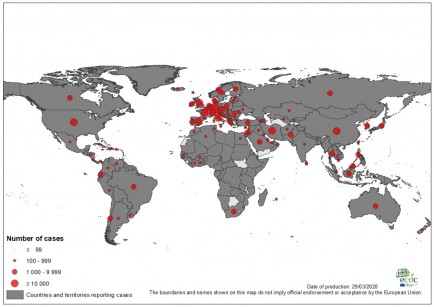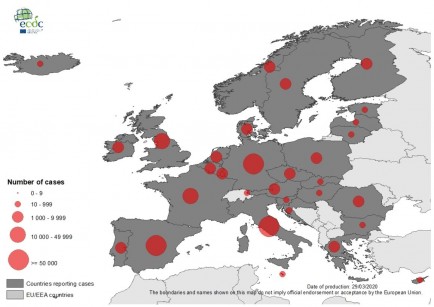It’s a scenario all too many of us are facing — or will soon face.
You or a loved one has a mild fever, body aches, the start of a nagging, dry cough. Food doesn’t taste good nor smell as it once did. Maybe you have shortness of breath or struggle to breath deeply.
You’ve called your doctor, and you are suddenly face-to-face with the scary reality of Covid-19.
What happens next depends on your specific circumstances. If you are having trouble breathing or are elderly and fragile, you may be hospitalized and tested for the virus.
If you’re not in immediate danger but potentially higher risk — you have underlying health conditions, such as diabetes, hypertension or lung issues; you’re over 60; or you are immune-compromised — you may be told to closely monitor your symptoms but shelter at home.
The rest of us with symptoms but no additional known risk factors will also certainly be told to stay home, rest and drink plenty of fluids, all while keeping a close eye on how we feel.
“People who are mildly ill with Covid-19 are able to recover at home,” the US Centers for Disease Control and Prevention says. “Do not leave, except to get medical care.”
Be sure to get care if you feel worse or you think it is an emergency, the CDC adds, but call first. And don’t use public transportation, ride-sharing or taxis to get there.
Now what? Are you prepared to take care of yourself if you’re alone? What can you do to protect other family members who have been exposed and will have to stay home with you?
Prepare in advance
Preparation is the key to a good plan.
Before anyone in your family or community gets sick, the CDC suggests checking in with loved ones, relatives, neighbors and friends to exchange phone numbers and emails and to find out if anyone will have special needs if they get sick. Have a list of your own emergency numbers handy. It should include your health care provider, local public health department, local hospital and ambulance service.
Hopefully, you’ve been following standard hygiene practices. These are behaviors we should be doing daily, automatically, to protect ourselves from germs, colds and flu:
Avoid touching your eyes, nose and mouth with unwashed hands; cough and sneeze into elbows or tissues that you immediately throw away, and regularly wash, wash, wash those hands with warm water and lots of soapy bubbles.
Check out this proper handwashing technique to try while singing along to a song. (If you’re tired of “Happy Birthday,” here are some cool tunes you can substitute.) When you can’t use soap and water, use hand sanitizer that is at least 70% alcohol and rub thoroughly.
The CDC says you should also be cleaning frequently touched surfaces daily with a regular household cleaner followed by a disinfectant. In addition to bathroom surfaces, tables and countertops, don’t forget light switches, faucets and sinks, cabinet handles, doorknobs, phones and keyboards.
Social distancing is critical to containing the virus; stay and work from home if that’s possible, and limit contact with others — no cookouts, no play-dates, no face-to-face dates.
When you do leave for life’s necessities, such as food and outdoor exercise, stay at least 6 feet away from others. (Make sure you can eyeball how long six feet actually is.)
Parents and guardians should plan well in advance by setting up a structure in which all kids and potential caregivers know their roles and expectations, said pediatrician Dr. Tanya Altmann, Editor-in-Chief of the American Academy of Pediatrics’ book “Caring for Your Baby and Young Child: Birth to Age 5 and The Wonder Years.”
“Many parents are going to get sick,” Altmann said. “So what’s the game plan? How are we going to isolate them and who’s going to be the backup parent? You need to know what to do so you’re not panicked and struggling if one parent gets a fever in the middle of the night.”
If possible, have a designated bedroom and private bathroom ready to use. Stock the room with all relevant forms of entertainment: TV, computer, iPad, books, even games that you could play via FaceTime or Skype.
Speaking of planning, here’s a list of some basic supplies to have on hand:
- A working thermometer to monitor fever, which is considered to be 100 degrees Fahrenheit (37.7 degrees Celsius), and a method to clean it, such as Isopropyl alcohol.
- Fever reducing medications, such as acetaminophen.
- A box of rubber or latex disposable gloves and face masks. Face masks are for the sick and caregivers only — they are in short supply and should not be used by those who are not sick, the CDC says.
- A 60- or 90-day supply of necessary prescription medicines.
- Regular soap and 70% alcohol-based hand sanitizer (antibacterial soap isn’t necessary if you wash properly, and that way you won’t will contribute to the world’s growing antibiotic-resistant superbugs).
- Tissues to cover sneezes and coughs. But there’s really no need to hoard toilet paper — this is a respiratory disease.
- Regular cleaning supplies, kitchen cleaning gloves and trash can liners.
Disinfectant cleaning supplies — the CDC suggests picking from a list that meets the virus-fighting standards of the US Environmental Protection Agency, but says you can also make your own version by using 1/3 cup unexpired bleach per gallon of water or 4 teaspoons bleach per quart of water. Never mix bleach with ammonia or any other cleanser — it produces toxic gases.
Isolate yourself or loved one
Once your healthcare provider tells you Covid-19 is suspected or confirmed, the CDC says you or your loved one should stay in a separate room (preferably with a private bathroom) away from other people in the household.
If you live alone, that’s not difficult. Your challenge is to monitor your symptoms and care for yourself when you’re not feeling well. Be sure to have a plan in place to deliver food and medications, and find someone who can be responsible for virtually checking in on you on a regular basis.
If you are part of a family, staying isolated can be challenging, especially if it’s a small space or there are children in the home.
“If you have somebody at home who’s older or immunocompromised, you may want to isolate them to one side of the house so the kids and everybody else aren’t around them on a regular basis,” Altmann said.
“If it’s a child that you have to care for, then you may have to make the decision to isolate one adult with the child,” she added. “That adult would be caring for the child, and the other adult would be responsible for the rest of family.”
And of course all of this will be extremely difficult for a single parent “who might be the only one,” said pediatrician Dr. Jenny Radesky, a spokesperson for the American Academy of Pediatrics.
“Know who your neighbors are, even what your neighborhood social network might be,” said Radesky, an assistant professor of pediatrics at the University of Michigan. “You may not be that close interpersonally, but someone may be willing to do a grocery store drop-off, or pick-up medications because we’re all in this together.”
Original article: https://edition.cnn.com/2020/03/25/health/how-to-prepare-for-coronavirus-quarantine-wellness/index.html




























Comments